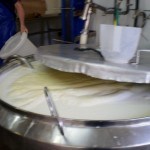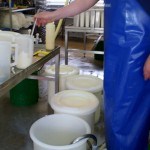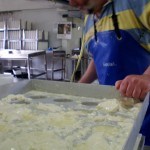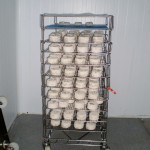Finn, an organic, double cream lactic-set cow’s milk cheese, made by Charlie and Haydn of Neal’s Yard Creamery, may look a little familiar to any Zingermans Creamery customers as it closely resembles theirManchester cheese. While different pastures, milk, breed of cows, and the natural recipe adjustments all cheesemakers use to personalise their cheeses will set the two apart, they seem to share common ground. This is less of a surprise when you learn that part of the extensive research carried out by John Loomis, Paul Saginaw, and Ari Weinzweig involved a research visit to Neal’s Yard Creamery to investigate cheese production.
Lactic cow’s milk cheese is a subject dear to my heart at the moment, as one of the dairies I’m working with is interested in making a Chaource-style cheese. When I heard about this, it pretty much clinched me wanting to work with them as I had been thinking of making Chaource myself when I set up on my own, inspired in part by Jasper Hill Farms’ Constant Bliss made over in Vermont, and also by a couple of very happy days at Hill Farm Dairy making Stawley with Caroline Atkinson. It therefore follows that while at Neal’s Yard Creamery, I was particularly keen to spend some time observing how they make Finn.
On the Tuesday morning, bright and early, Charlie set off with their little trailer and tank (and yours truly in the passenger seat), heading for the farm to collect milk. The cows milk is collected a mere half hour away, near Glasbury on Wye, at the farm of Andrew and Rachel Giles. Their cows are New Zealand Friesian, where Zingermans Creamery’s Manchester is made using milk from Dutch-Belted cows. As a breed, New Zealand Friesian are very similar to the old British Friesian, and as such have higher levels of fats and proteins than the industry standard (Holstein or Holstein Friesian cross.) There are a few Jerseys as well, whose influence is probably pretty diluted across the herd as a whole, but will give a little extra richness. They are also farmed on a New Zealand system, being out on grass for as long as possible, and requiring less concentrates and a more natural feeding regime.
As we arrived at the farm, the milking was in progress, and all seemed calm and under control. We greeted the milkers and unloaded milk from the bulk tank into our little tank on the trailer. As we filled the tank, I could see the cows that had been milked earlier happily making their way back to the fields. They know their way back without a guide. Back at Neal’s Yard Creamery, the milk was ready to process. Starter had been made up, and was added. Double Cream was added too, and the buckets left with the milk ripening. It follows the same lactic process as the goat’s milk: rennet late afternoon, and ladling the following morning, but the composition and cream content are less co-operative than with the goat’s milk. Cow’s milk will separate out into milk and cream more readily than sheep or goat’s milk, especially when kept at warm temperatures such as the 22 degrees C or thereabouts that lactic cheeses like to set at. The danger when making a lactic cheese is your cream separates out on top, and forms a set cream cheese separate from the other curd. To counteract this, Haydn goes back after the rennet has been added, but before it is actually set, and stirs the cream back in again. This is something I have tried too, when making a couple of batches of Jersey milk cheese, and getting the timing right is by no means easy, believe me. However, if done correctly, the following morning the curd has a lovely clear whey pool above it, and the cream is integrated into the mix. Thankfully, this is exactly what we found the following morning when checking the pH.
For the Finn, Charlie bought a set of rigid, interlinked moulds, and draining trays to fit them, so they can be stacked as high as the ladler can reach on the draining table. In my case, that’s not actually all that high, but for the considerably taller Charlie and Haydn, that’s a great space-saving advantage. They are also beautifully simple to use. No moulds tipping over or slipping about, you just ladle and ladle until they are full up, then pop a tray and another set of moulds on top, and off you go again. As for washing? Well, they would be a bit tricky to clean by hand, but if you have a dishwasher there’s no problem. And frankly, if you are making over 400 Ragstones a week, never mind Dorstones, Perroche, Perroche logs for catering, Goats Curd, Finn & Cows Curd, a dishwasher is something you will definitely need. Another thing I was keen to find out about the Finn, is how to control bitter flavours that are an inevitable part of fat breakdown. Neal’s Yard Creamery has this partly under control by pumping the milk more gently, so that it is handled carefully as it comes in from the tank.
Another aspect in developing the flavour has been dropping the temperature at which rennet is added, but rather than protect the fats, this allows greater complexity of flavour to develop from the starter bacteria. However, it all contributes to having a rich, buttery, lactic flavour that showcases the best of the cream and none of the down sides.
- Heating milk and cream together to the correct temperature for the starter to be added.
- Haydn Roberts adds rennet to individual buckets of acidifying milk and cream.
- The following morning, the curd is ready to be laid into moulds.
- Haydn ladles curds into the multi moulds and piles them high.
- Racks of Finn in the cold rooms, maturing.









